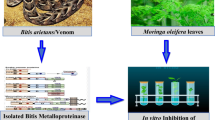Abstract
Bee venom is used as a traditional medicine for treatment of arthritis. The anti-inflammatory activity of then-hexane, ethyl acetate, and aqueous partitions from bee venom (Apis mellifera) was studied using cyclooxygenase (COX) activity and pro-inflammatory cytokines (TNF-α and IL-1β) production,in vitro. COX-2 is involved in the production of prostaglandins that mediate pain and support the inflammatory process. The aqueous partition of bee venom showed strong dose-dependent inhibitory effects on COX-2 activity (IC50 = 13.1 μg/mL), but did not inhibit COX-1 activity. The aqueous partition was subfractionated into three parts by molecular weight differences, namely, B-F1 (above 20 KDa), B-F2 (between 10 KDa and 20 KDa) and B-F3 (below 10 KDa). B-F2 and B-F3 strongly inhibited COX-2 activity and COX-2 mRNA expression in a dose-dependent manner, without revealing cytotoxic effects. TNF-α and IL-1β are potent pro-inflammatory cytokines and are early indicators of the inflammatory process. We also investigated the effects of three subfractions on TNF-α and IL-1β production using ELISA method. All three subfractions, B-F1, B-F2 and B-F3, inhibited TNF-α and IL-1β production. These results suggest the pharmacological activities of bee venom on anti-inflammatory process include the inhibition of COX-2 expression and the blocking of pro-inflammatory cytokines (TNF-α, and IL-1β) production.
Similar content being viewed by others
References
Barrios-Rodiles, M., Tiraloche, G., and Chadee, K., Lipopoly-saccharide modulates cyclooxygenase-2 transcriptionally and posttranscriptionally in human macrophages independently from endogenous IL-1β and TNF-α.J. Immunol., 163, 963–969 (1999).
Billingham, M. E., Morley, J., Hanson, J. M., Shipolini, R. A., and Vernon, C. A., Letter: An anti-inflammatory peptide from bee venom.Nature, 245, 163–164 (1973).
Carteron, N. L., Cytokines in rheumatoid arthritis: trials and tribulations.Mol. Med. Today, 6, 315–323 (2000).
Creminon, C., Habib, A., Maclouf, J., Pradells, P., Grassi, J., and Frobert, Y., Differential measurement of constitutive (COX-1) and inducible (COX-2) cyclooxygenase expression in human umbilical vein endothelial cells using specific immunometric enzyme immunoassays.Biochim. Biophys. Acta, 1254, 341–348 (1995).
Dinarello, C. A., Role of pro- and anti-inflammatory cytokines during inflammation: experimental and clinical findings.J. Biol. Regul. Homeost. Agents, 11, 91–103 (1997).
Gauldie, J., Hanson, J. M., Rumjan, F. D., Shipolini, R. A., and Vernon, C. A., The peptide components of bee venom.Eur. J. Biochem., 61, 369–376 (1976).
Habermann, E., Bee and wasp venoms.Science, 177, 314–322 (1972).
Hanson, J. M., Morley, J., and Soria, C., Anti-inflammatory property of 401, a peptide from the venom of the bee(Apis mellifica L).Br. J. Pharmacol., 46, 537–538 (1972).
Kwon, Y. B., Lee, J. D., Lee, H. J., Han, H. J., Mar, W., Kang, S. K., Beitz, A. J., and Lee, J. H., Bee venom injection into an acupuncture point reduces arthritis associated edema and nociceptive responses.Pain, 90, 271–280 (2001).
Liang, Y. C., Huang, Y. T., Tsai, S. H., Lin-Shiau, S. Y., Chen, C. F., and Lin, J. K., Suppression of inducible cyclooxygenase and inducible nitric oxide synthase by apigenin and related flavonoids in mouse macrophages.Carcinogenesis, 20, 1945–1952 (1999).
Lin, W. W., Chen, B. C., Hsu, Y. W., Lee, C. M., and Shyue, S. K., Modulation of inducible nitric oxide ynthase induction by prostaglandin E2 in macrophages: distinct susceptibility in murine J774 and RAW 264.7 macrophages.Prostaglandins Other Lipid Medial, 58, 87–101 (1999).
Mitchell, J. A., Saunders, M., Barnes, R. J., Newton, R., and Belvisi, M. G., Sodium salicylate inhibits cyclo-oxygenase-2 activity independently of transcription factor (nuclear factor KB) activation: Role of arachidonic acid.Mol. Pharmacol., 51, 907–912 (1997).
Mosmann, T., Rapid colorimetric assay for cellular growth and survival: application to proliferation and cytotoxicity assays.J. Immunol. Methods, 65, 55–63 (1983).
Osullivan, M. G., Huggins Jr., E. M., Meade, E. A., DeWitt, D. L., and McCall, C. E., Lipopolysaccharide induces prostaglandin H synthase-2 in alveolar macrophages.Biochem. Biophys. Res. Commun., 187, 1123–1127 (1992).
Schagger, H. and von Jagow, G., Blue native electrophoresis for isolation of membrane protein complexes in enzymatically active form.Anal. Biochem., 199, 223–231 (1991).
Shkenderov, S. and Koburova, K., Adolapin-a newly isolated analgetic and anti-inflammatory polypeptide from bee benom.Toxicon., 20, 317–321 (1982).
Simon, L. S., Role and regulation of cyclooxygenase-2 during inflammation.Am. J. Med., 106, 37S-42S (1999).
Wadleigh, D. J. and Herschman, H. R., Transcriptional regulation of the cyclooxygenase-2 gene by diverse ligands in murine osteoblasts.Biochem. Biophys. Res. Commun., 264, 865–870 (1999).
Warner, T. D., Giuliano, R., Vojnovic, I., Bukasa, A., Mitchell, J. A., and Vane, J. R., Nonsteroid drug selectivities for cyclo-oxygenase-1 rather than cyclo-oxygenase-2 are associated with human gastrointestinal toxicity: A full in vitro analysis.Proc. Natl. Acad. Sci. USA, 96, 7563–7568 (1999).
Zurier, R. B., Mitnick, H., Bloomgarden, D., and Weissmann, G., Effects of bee venom in experimental arthritis.Ann. Rheum. Dis., 32, 466–470 (1973).
Author information
Authors and Affiliations
Corresponding author
Rights and permissions
About this article
Cite this article
Nam, KW., Je, KH., Lee, J.H. et al. Inhibition of COX-2 activity and proinflammatory cytokines (TNF-α and IL-1β) production by water-soluble sub-fractionated parts from bee (Apis mellifera) venom. Arch Pharm Res 26, 383–388 (2003). https://doi.org/10.1007/BF02976695
Received:
Issue Date:
DOI: https://doi.org/10.1007/BF02976695




